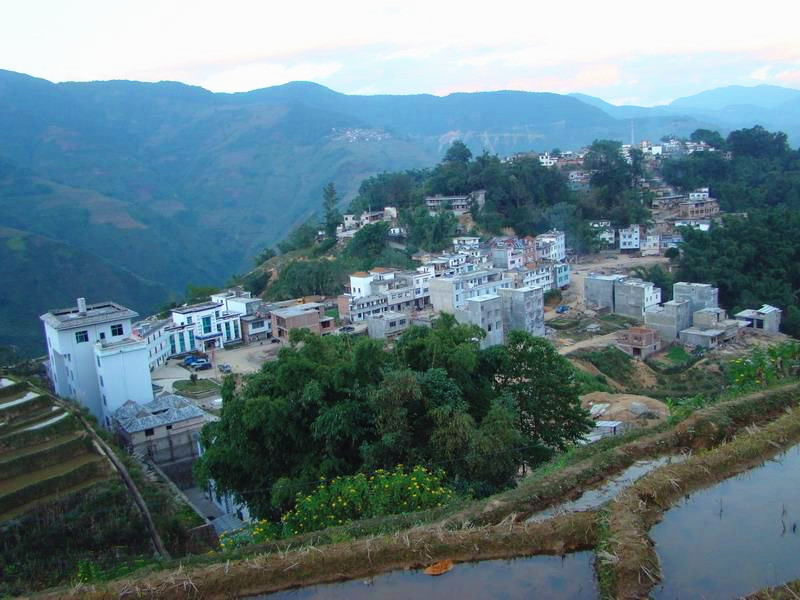
Habo Village in Yuanyang County, Honghe
Overview
Habo Village (哈播村) is located in the Ezhai Township (俄扎乡) of Yuanyang County (元阳县), Honghe Prefecture (红河哈尼族彝族自治州), Yunnan Province (云南省). It lies to the north of Ezhai Township, accessible via unpaved roads, with a distance of several kilometers from the county seat. To the east, it borders Huangcaoling Township (黄草岭乡) and Hage Village Committee (哈更村委会), to the west, Hajiakou Village Committee (哈脚村委会), and to the north, Mengzhong (勐仲) and Santai Po (三台坡). Habo Village is composed of five village groups, including Habo, Duosha, and Chujiao, with a total of 828 households and a population of 3,357, all engaged in agriculture, with a labor force of 2,452.
Location
Habo Scenic Area (哈播景区) is situated 115 kilometers south of Yuanyang County Town (元阳县县城) and 85 kilometers south of Xinjie (新街). Habo Village, established in the late Ming Dynasty (approximately 1620), is a Hani (哈尼族) village located on an oval hill at an altitude of 1,350 meters, with 460 households and a population of 2,639. It has gained worldwide recognition for its annual traditional Long Street Feast, known as the “Angma Tu” Festival (昂玛突节).
Main Attractions
Habo Terraces
The Habo Terraces encircle the village in a circular pattern. From the eastern part of the village, one can observe dozens of semi-circular ridges at a 45-degree slope, adorned with hundreds of crescent-shaped rice terraces climbing from the river valley. As the sun rises, these terraces shine in red, creating a stunning visual spectacle. The Habo Terraces are renowned as the steepest and most three-dimensional in Yuanyang, making it the best location to view sunrise over the terraces.
Habo Architecture
The architecture of Habo Village harmonizes with the landscape. The various architectural styles of the Hani ethnic groups are represented here, including square four-room houses with a central courtyard from the Luobi (罗碧) branch, square wooden balconies from the Luomian (罗缅) branch, and rectangular houses from the Dunhong (敦宏) branch. Modern constructions are also evident, featuring early forms of mushroom-shaped houses.
Habo Village Culture
Known as a land of song and dance, Habo Village boasts a rich tradition where all ages participate in performing arts. During significant festivals or celebrations, traditional and modern songs and dances are showcased. Notable performances such as the Hani Wooden Drum Dance, Palm Fan Dance, Bowl Dance, and Sparrow Dance originated from Habo Village. The surrounding area features approximately 190,000 acres of terraces spread across 2,289 square kilometers, with the most spectacular views located in Niu Jiao Zhai (牛角寨), Liangxin Zhai (良心寨), Xin’ansuo (新安所), and Guoqi (果期).
Local Customs
The scenic area is a hub for Hani ethnic customs, music, dance, and rice culture, making it an excellent place for studying Hani festivals and traditions. The Habo customs are well-preserved and vibrant, with the “Angma Tu” Festival held annually on the first Ox day of the lunar calendar, featuring over 260 banquet tables set up along the street, forming the world’s longest Long Street Feast, celebrated with songs and dances.
The “Angma Tu” Festival marks the end of the year’s labor and the onset of the new spring farming season, commemorating Angma and Anghou, who are believed to have protected the people. Habo Village is often referred to as the hometown of Hani dining culture and the Long Street Feast due to the completeness and grandeur of its festival rituals.
Long Street Feast
The Long Street Feast is a significant event during the “Angma Tu” Festival, characterized by both solemnity and mystery. It occurs on the first Ox, Tiger, or Rabbit day of the lunar month, spanning three days. On the day of the festival, the host, known as “Migu” (咪谷), sacrifices pigs and chickens at the village’s sacred tree before hosting the feast. Each family sets out one to two tables of food, aligned along the street to create a long banquet, symbolizing shared prosperity and blessings for a bountiful year.
How to Get There
Habo Village can be accessed from Yuanyang County Town by taking local transport options. Due to the rural nature of the area, it is advisable to rent a vehicle or hire a local driver familiar with the terrain.
Travel Tips
- Accommodation: Options in nearby towns or local guesthouses in Habo.
- Best Time to Visit: The Angma Tu Festival is a highlight, but visiting during rice planting or harvest seasons can also be rewarding.
- Local Cuisine: Don’t miss the opportunity to taste Hani dishes during the Long Street Feast.
- Respect Local Customs: Engage respectfully with the local culture, especially during festivals.
- Prepare for Terrain: Roads may be unpaved; ensure your vehicle is suitable for such conditions.

Location:

 7 Days GolfingTour
7 Days GolfingTour
 8 Days Group Tour
8 Days Group Tour
 8 Days Yunnan Tour
8 Days Yunnan Tour
 7 Days Shangri La Hiking
7 Days Shangri La Hiking
 11 Days Yunnan Tour
11 Days Yunnan Tour
 6 Days Yuanyang Terraces
6 Days Yuanyang Terraces
 11 Days Yunnan Tour
11 Days Yunnan Tour
 8 Days South Yunnan
8 Days South Yunnan
 7 Days Tea Tour
7 Days Tea Tour
 8 Days Muslim Tour
8 Days Muslim Tour
 12 Days Self-Driving
12 Days Self-Driving
 4 Days Haba Climbing
4 Days Haba Climbing
 Tiger Leaping Gorge
Tiger Leaping Gorge
 Stone Forest
Stone Forest
 Yunnan-Tibet
Yunnan-Tibet
 Hani Rice Terraces
Hani Rice Terraces
 Kunming
Kunming
 Lijiang
Lijiang
 Shangri-la
Shangri-la
 Dali
Dali
 XishuangBanna
XishuangBanna
 Honghe
Honghe
 Kunming
Kunming
 Lijiang
Lijiang
 Shangri-la
Shangri-la
 Yuanyang Rice Terraces
Yuanyang Rice Terraces
 Nujiang
Nujiang
 XishuangBanna
XishuangBanna
 Spring City Golf
Spring City Golf
 Snow Mountain Golf
Snow Mountain Golf
 Stone Mountain Golf
Stone Mountain Golf



















